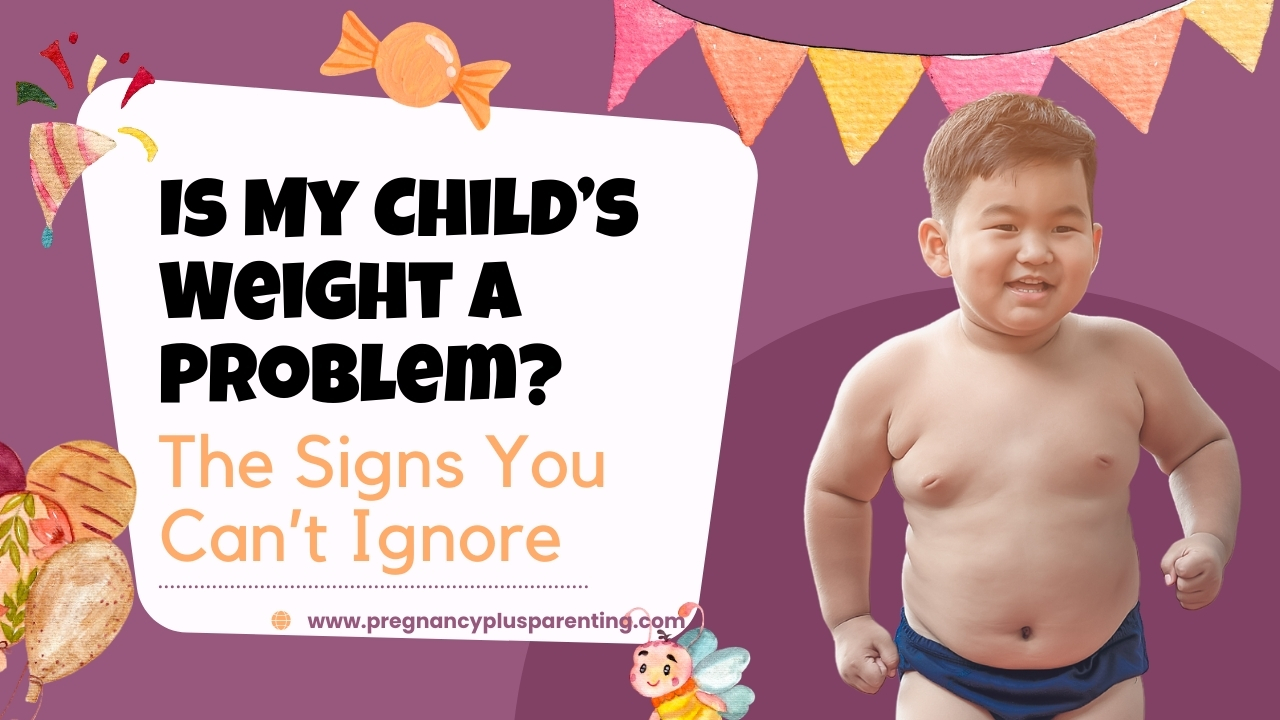Is My Child’s Weight a Problem? The Signs You Can’t Ignore
Are you worried about having a fat child and wondering at what age children are considered overweight?
What are the reasons behind this? How can we support such children? What needs to be changed?
But before you drive yourself crazy because you know that overweight children are teased, you should first do a reality check and check whether your child is actually overweight.
Being a mother has never been easy, but don’t lose control, get informed first.
This is done by reading the so-called percentile curves and calculating the BMI value (BMI stands for body mass index).
In any case, if you suspect that your child is overweight, you should visit your pediatrician.
This article is about the reasons behind the increasing number of overweight children in Germany, the health risks involved and how these children can be supported.
Fat child – alarming figures
It can be no coincidence that obesity among children has increased immensely.
The Children’s Health Foundation even says that obesity and overweight have reached epidemic proportions, which should also be the responsibility of society and politics.
Dr. Berthold Koletzko, a metabolism expert at the University Children’s Hospital in Munich and chairman of the Children’s Health Foundation, explains that the prevalence of overweight and obesity among children and adolescents has increased eightfold in the last 40 years.
A recent analysis of 416 studies involving a total of over 160 million children and adolescents from 200 countries found that the proportion of overweight girls increased from 0.7% in 1975 to 5.6% in 2016 and the proportion of boys from 0.9% to 7.8%.
The Robert Koch Institute conducts studies on the health of children and adolescents in Germany.
After collecting data from the long-term KiGGS study, it was found that as many as 15% of children and adolescents aged three to seventeen are overweight, while 6.3% suffer from obesity.
Fat child – When is a child overweight and obese?
Overweight and obesity have nothing to do with baby fat and, contrary to what some parents believe, it does not go away over time.
So it can actually be true if you say: once fat, always fat.
Since overweight children not only suffer from teasing but also from significant health problems, it is important to keep an eye on their weight development so that you can intervene immediately if alarming signs appear.
By the way, it’s not advisable to estimate your child’s weight by eye. Why?
Because in many cases parents have difficulty making a realistic assessment and in the case of overweight children, significantly more than half have a false perception.
At least, this is what a study by the Psychological Institute of the University of Potsdam showed. 200 mothers were asked to choose silhouettes that matched the body contours of their children.
40% of mothers were wrong, while even 80% of mothers of overweight children made incorrect assessments.
So, you’ll need to do some math and consult charts. To do this, record your child’s height in centimeters and weight in kilograms.
1. BMI calculator for children and adolescents
If you have ever used a BMI calculator for yourself, please note that this is not suitable for calculating your child’s BMI, as the ratio of height to weight constantly changes as children grow up.
Then results for children have to be evaluated differently, which is taken into account with the BMI calculator for children and adolescents of the Professional Association of Paediatricians.
The calculator interprets the result and gives you specific tips on how to proceed.
So if your child’s value is in the upper range of normal weight, you should check your child’s height and weight regularly, and if the value suggests overweight, it is recommended that you visit a pediatrician.
Ultimately, only the doctor can accurately assess your child’s health condition, identify risk factors, and discuss improvement measures that are tailored specifically to your child.
Then there is the possibility of taking a look at the child’s U-examination booklet, because there are curve diagrams shown there, which are called percentile curves in professional circles and can provide information about whether the child has a normal weight or not.
2. Percentile curves: How to read them
There are separate percentile curves for boys and girls because the development of the two sexes proceeds differently.
The individual curves in the diagrams have different names. Curve P50 indicates the normative value, meaning that 50% of children of the same age have this weight.
There are also the following curves that indicate abnormalities:
• P3 states that only 3% of peers have such a low weight, which indicates severe underweight.
• P10 indicates that 10% of peers are the same weight, which also indicates underweight.
• P25 means that your child is lighter than three-quarters of their peers, but this is not a cause for concern as the value is not in the underweight range, but simply means that the child is more petite than most.
• P90 indicates that the child is heavier than 90% of their peers and is therefore overweight.
• P97 means the child is heavier than 97% of their peers and indicates obesity. Urgent action should be taken.
Fat child – What are the reasons behind the kilos?
There can be various reasons why a child is overweight or obese.
In addition to parental upbringing and eating habits, social environment and genetics can also influence body weight and cause your child to be overweight than others.
While it’s true that some people can eat more than others and still not gain weight, and that this may be due to genetics, the reasons why people get fat are ultimately the same for both adults and children: you consume more calories than you burn.
This means that overweight children are likely to exercise too little and eat and drink too many calories, may not have set meal times but instead have more snacks and consume lots of sweets and sugary drinks.
Eating habits are usually adopted from the parents.
And once the excess weight has become entrenched, the metabolism is regulated by the diencephalon in such a way that excess weight appears to be the norm and losing weight can therefore be extremely difficult.
In addition, the advertising of high-calorie foods and sweet drinks and their easy accessibility also encourages their consumption.
And nowadays children sit in front of screens, cell phones, smartphones and tablets far too often and for too long and move less often than was the case in the past.
Have you heard that sitting is the new smoking? US researcher James Levine expressed the health consequences of prolonged sitting with this catchy slogan.
And if parents sit a lot, their children usually do too, meaning they can hardly burn any calories.
Many children are taken to school by car and rarely play on the streets.
Video games are now in vogue. Soft drinks, fruit juices, and fast food are also on the menu.
Many children grow up with disordered eating behavior by being rewarded with sweets or snacks or by being comforted or soothed.
For example, you can quickly push a bag of gummy bears under your child’s nose to comfort them on the way to the doctor, or give in when they throw a chocolate bar onto the conveyor belt at the checkout.
You know that it’s too much of a good thing and unhealthy, but you don’t want to argue with your child in public, and you don’t have the nerve for consistent arguments at home.
This leads to a vicious circle that becomes increasingly difficult to break the older the child gets.
In addition, the following causes of overweight and obesity are possible:
• Smoking household: According to statistics, the offspring of smokers are fatter than those of non-smokers.
• Statistics also show that children who were breastfed are more likely to be of normal weight, and those who were bottle-fed instead are more likely to gain excess weight.
• If the mother suffered from gestational diabetes, the offspring is at increased risk of obesity.
• Like parents, like children: It has been found that 80% of overweight toddlers have overweight parents.
• Children from disadvantaged social backgrounds are more likely to be overweight.
Obese child – A long list of dangerous health consequences
Parents should be aware that overweight and obese children do not become slim as they grow up, says Professor Koletzko, and that the health risks are very high.
Overweight and obesity can lead to high blood pressure, heart attacks, diabetes, strokes, diseases of the musculoskeletal system, liver cirrhosis, even cancer and, in addition, mental disorders, including reduced performance and depression.
Studies show that the risk of death among overweight adolescents increases by 4.9 times compared to normal-weight peers within the next forty years of life, while the risk of death caused by cardiovascular disease increases by 3.5 times.
Overweight children experience faster growth and, due to the higher production of sex hormones, puberty can also begin earlier.
Back pain, tears in the connective tissue, certain foot deformities such as splayed or flat feet, and bow or knock knees are also typical consequences of overweight and obesity.
In addition, overweight adolescents have a 1.4-fold increased risk of psychological stress and disorders, while obese adolescents have a 2.5-fold increased risk.
Life expectancy is shortened by 2.5 years for overweight people and by six to eight years for obese people.
This is why experts believe that obesity can be even more dangerous than cancer, because severe obesity shortens life more than some malignant diseases.
Fat child – what can you do?
There is no question that everyone wants confident and happy children and that it hurts parents when their child is teased or suffers.
It is a very difficult task to support the child in such a way that the situation does not get worse and the child does not even feel rejected by the parents.
This is probably why some parents ignore the problem, but by doing so they are not doing anyone a favor, least of all the child themselves.
It is therefore important to choose the words addressed to the child carefully and sensitively so that they do not hurt or undermine their already shaky self-esteem.
Diets are not a good idea at all, especially for young children, and they are rarely successful with teenagers either, and can lead to increased frustration if they do not work or if you are unable to stick to them.
The child must definitely feel accepted and valued, at least by their immediate environment, to be able to do this themselves. Furthermore, they should, first and foremost, develop a good body image.
This happens with regular exercise and fun activities, even before the pounds start to fall off.
In general, losing weight should not be the focus at first, but rather a holistic lifestyle change that will eventually make this possible.
1. Review eating habits and ensure healthy nutrition
A study by the Robert Koch Institute has shown that almost 10% of parents are not aware of the importance of healthy eating and what needs to be taken into account.
Of course, this has to change, because healthy eating habits are one of the cornerstones of a healthy body weight.
Society and politics are called upon to provide information and reach out to these families.
However, this alone is far from enough, as the Children’s Health Foundation makes clear.
Although the World Health Organization has made certain demands on legislators, such as that food quality be uniformly indicated by simple symbols, the food industry is successfully resisting such legal regulations through lobbying.
In addition, children continue to be constantly exposed to unhealthy foods through advertising, and manufacturers often cheat.
A well-known example is the Monte Drink, which was advertised by the manufacturer as a healthy snack, even though it contains more sugar and calories than cola.
For this, Monte received the negative “Golden Windbeutel” award from the Foodwatch association in 2010. Monte is by no means alone in this.
Some breakfast cereals are considered healthy, but are often over-sweetened, high-calorie snacks are often advertised as suitable for children, and industrially produced goods are marketed as premium products.
The Children’s Health Foundation is calling for stricter legal regulations and official monitoring.
Until that happens, the problem of the increasing number of overweight and obese children unfortunately remains mainly in the hands of parents, although combating obesity is urgently needed from an economic point of view.
And parents have to fight against sophisticated strategies of the food industry.
Coca-Cola, Haribo, and McDonald’s have signed well-known influencers to promote their unhealthy products. You can sign a petition against this marketing here.
Most people know that five portions of fruit and vegetables a day are part of a healthy and balanced diet.
In daycare centers, children are usually accustomed to fruit plates and sugar-free drinks. However, this doesn’t mean they bring these eating habits home with them.
If the parents often eat fries and fast food, chocolate and chips, then the child will too.
The transition to a healthy diet must therefore be a holistic family affair, and this is no easy task, nor can it be accomplished overnight. It requires a strong will, including the ability to cook, as well as perseverance.
Realistic goals should be set and implemented in small steps.
With small children, it is advisable not to even discuss the change in diet because they often accept it silently and do not question it.
2. Get moving
It turns out that a full 80% of children in Germany do not exercise enough!
In view of the alarming figures, the World Health Organization even issued a guideline on physical activity for children up to five years of age in 2019 .
Of course, it makes a difference whether your child has just turned one or whether they are older, but in general, children should never spend more than an hour sitting down, be it in the car, in a buggy or in front of the television.
Even the youngest children should get an hour of exercise a day, and as children get older, at least three hours of alternating moderate and strenuous exercise per day should be included. Here are some tips to help you achieve this:
1. Regular walks with small tasks: Toddlers are constantly collecting, so you can take advantage of this opportunity to collect stones, sticks, leaves, flowers, chestnuts, pine cones, etc. along the way.
Bending over and standing up regularly is a good exercise while walking.
2. Regularly visit an animal shelter or zoo: Children are always excited to visit animals, so take regular walks or bike rides to the animal shelter or a nearby park where you can see breeding animals. Leave the stroller at home.
3. Join in with movement games: Your child will usually try to imitate you, so you could hop on one leg, walk on all fours, play catch, or play with a ball in a meadow or park.
4. Go to the playground regularly: Encourage your child to climb on the climbing frame or slide.
Toddlers can repeat something like this many times without getting bored.
5. Set a good example: Take the stairs instead of the elevator or escalator and walk as much as possible.
So instead of doing a big shopping trip by car once a week, you can do smaller shopping trips with your child several times on foot.
6. Assign everyday tasks: At first glance, this doesn’t seem to have much to do with it, but you can also encourage exercise and, beyond that, good habits and independence with household chores .
Your child should not just be served, but should be happy to empty the dishwasher, change the bed linens and take out the trash.
7. Arrange a children’s gathering: How about gathering children who go to daycare with your daughter or son on weekends and organizing group games with them on the playground ?
Perhaps together with other parents or as the sole caregiver if there are not too many children.
8. Inquire with clubs: Many sports programs are available for young children . So why not introduce your child to soccer, ballet, or gymnastics?
Maybe he likes something particularly well and the course can be set for a long-term hobby.
9. Obstacle Course: If you live in a house or a larger apartment, or if you have a garden, you can set up obstacle courses with your child so that they can jump over obstacles, climb, or crawl through them.
10. Request playgroups: Another great way to not only get exercise but also to socialize is to join local playgroups if your child isn’t already in daycare.
3. Limit media consumption
Most parents find it extremely difficult to limit their children’s media consumption.
But children are dependent on their parents’ rules because they do not yet have the ability to regulate themselves.
And no, it is not an exaggeration or scaremongering that children have no place in front of audiovisual media such as television, smartphones and tablets, because it has been proven that media consumption can have extremely negative effects on development.
In the Blikk Media Study, conducted across Germany in 2016 and 2017, over 5,500 children and young people were examined for their media use.
The researchers concluded that there are significant statistical correlations between increased electronic media consumption and developmental disorders such as hyperactivity, concentration disorders and language development disorders.
Increased BMI values were also detected.
Research into media consumption and media addiction is still in its early stages, and further long-term health consequences in adulthood are largely unknown.
It is recommended that children be introduced to media consumption slowly from the age of three.
Up to the age of five, a child should not spend more than 20-30 minutes per day in front of the television, PC, tablet or mobile phone, but even in later years it should not be more than one to two hours.
Here, too, the role model function of parents is important. If mom and dad sit down in front of the TV right after work or frequently use their smartphones, then the child cannot be expected to accept restrictions.
Ultimately, when introducing media to children, it’s important to find and offer child-friendly content. You can easily find information about this online.
For example, the German Youth Institute has developed a database that lists and rates apps for children .
Fat child – seek help
Obese and overweight people know how difficult it is to cope with everyday life and how difficult, if not almost impossible, it is to improve themselves.
All the advice above is well-intentioned and can be helpful in some cases.
But if not only children are affected by overweight and obesity, but also the parents, then it takes more than just a few well-intentioned tips and you should seek professional help and support.
And unfortunately, this is still difficult in our society. Those affected report the numerous bureaucratic hurdles presented by their health insurance companies.
Did you know that not even all doctors consider obesity a disease?
One place where you can get help is, for example, the non-profit organization Initiative Gesundgewicht eV, which provides information and works to ensure that obesity is recognized as a disease.
In addition, further information and advice on treatment options and possible reimbursement by health insurance companies are offered there.
The Obesity Self-Help Association , as a community for those affected, offers the largest database of specialists and self-help groups in the German-speaking countries of Germany, Switzerland and Austria.
The aim of this community is to support those affected in the fight against obesity, to enable an exchange of experiences and to provide information about treatment options.
Final thoughts
The figures on overweight and obesity in childhood and adolescence presented in this article are frightening and alarming, as studies show that one in seven children in Germany between the ages of three and seventeen is overweight.
This worrying trend of steadily increasing numbers has been observed for 40 years, and the Children’s Health Foundation is also drawing attention to this.
Increased media consumption, high-calorie diets and lack of exercise have contributed to this dangerous trend.
Unfortunately, society and politics are still not doing enough to encourage the food industry to adopt sensible and consumer-friendly regulations.
Many manufacturers use questionable marketing strategies to entice even the youngest target group to consume unhealthy snacks and sugary drinks.
That’s why parents need to be even more careful and take action to counteract this.
Here I have explained when and by what criteria a child is considered overweight or obese and given tips on how to help them lose the weight.
Since it is not uncommon for overweight children to have overweight parents and outside help is needed to address the problem, I have also listed some contact points that provide advice and information on therapy options.
In fact, those affected and their families are still fighting today to ensure that obesity is recognized as a disease by all doctors and not simply viewed as a sign of an unhealthy lifestyle.
Considering the serious health consequences that can occur, that’s not a bad idea.






